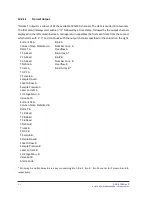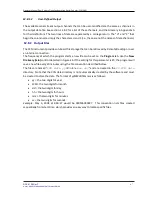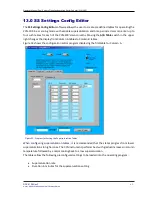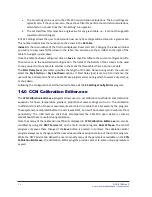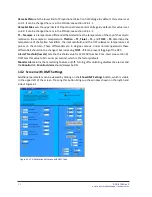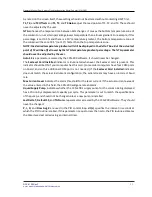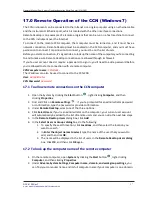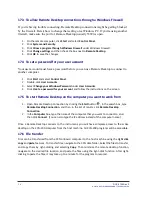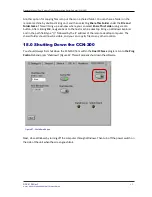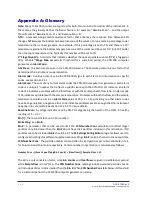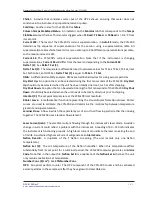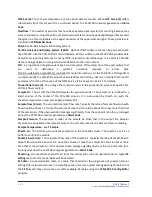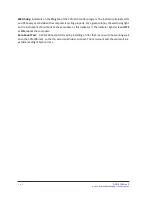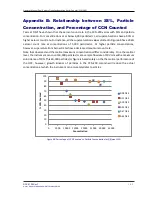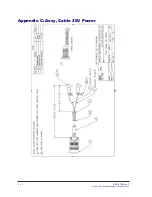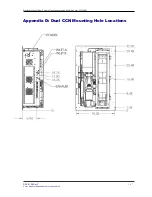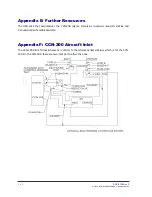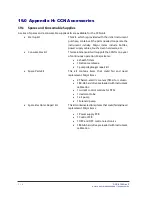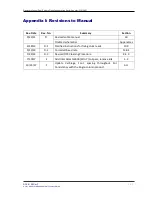
DOC-0128 Rev F
© 2017 DROPLET MEASUREMENT TECHNOLOGIES
1 0 0
Appendix A: Glossary
Note:
Many CCN-200 channels are reported for both Column A and Column B of the instrument. In
these cases, the glossary defines the basic channel—for example, “Baseline Mon.”—and the output
file will contain “Baseline Mon. A” and “Baseline Mon. B.”
%TG:
A temperature-gradient adjustment factor that enhances the response time between SS%
changes.
%TG
causes the bottom temperature zone of the column to run a certain percentage lower
temperature than a linear gradient. For example, if this percentage is set to 5% and there is a 10°
temperature gradient, the bottom temperature zone of the column will be set at 9.5° (not 10°) hotter
than the top temperature zone. Typically this number will be set to 7%.
1
st
Stage Mon (V):
A monitor that indicates whether the optical particle counter (OPC) is fogged or
dirty. When
1
st
Stage Mon
exceeds its threshold for a sustained period, the CCN-200 computer
generates an
Alarm Code.
Abs Press:
The absolute pressure in the CCN-200 columns. The absolute pressure is one factor that
determines the instrument’s supersaturation.
Alarm code:
A unique numeric value the CCN-200 assigns to each alarm. For information on specific
codes, see section 12.2.5.1.
Alarm Sum:
The sum of any current alarm codes the CCN-200 computer has generated. Each alarm
code is a unique 2
n
number that reflects a specific issue with the CCN-200. For instance, an alarm
code of 4 indicates a problem with the total flow or with the sample-sheath flow ratio. An alarm code
of 16 indicates a problem with the sample temperature. Problems with both the flow and the sample
temperature would result in an
Alarm Code
value of 20 (= 4 + 16), providing no other alarm codes
have been generated. A negative alarm code indicates problems severe enough that the instrument
has gone into safe mode. See section 12.2.5.2 for more details.
Baseline Mon.:
A voltage indicator used by DMT for diagnosing the health of the OPCs. A healthy
reading is 2.5 – 3.2 V.
Bin [
i
]:
The raw particle count in bin number
i
.
Bin Setting:
See
Bin #.
Bin #:
A parameter that can be used to limit the
CCN
Number Conc
calculation to reflect larger
particles only. Bins lower than the
Bin #
do not have their particles included in this calculation. If all
particles are to be included,
Bin #
should be 0. The
SS Settings Config Editor
program allows users to
configure bin settings for different supersaturation settings.
Bin #
is also a channel in the output data.
CCN Number Conc
: The particle number concentration
in sized particles per cubic centimeter of air,
for Column A and Column B respectively. Particle number concentration is calculated as follows:
Number Conc = [(Sum of qualifying Bin Counts) + (Overflow)] / Sample Flow
•
60
The 60 is a unit conversion factor, since
Bin Counts
and
Overflow
are given in particles per second
while
Sample flow
is in cm
3
/min. The
CCN
Number Conc.
readings include oversized particles but do
not include particles in bins smaller than the
Bin #.
When
CCN Number Conc
falls below its threshold
for a sustained period, the CCN-200 computer generates an alarm
.

